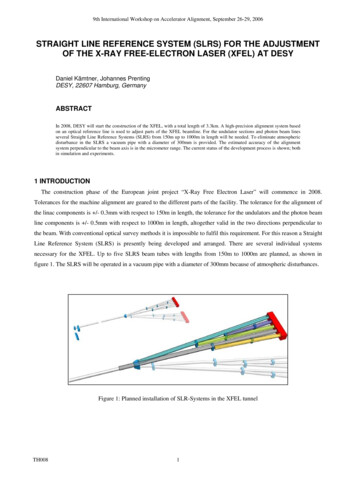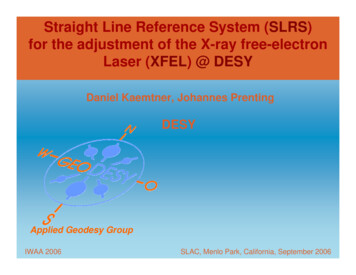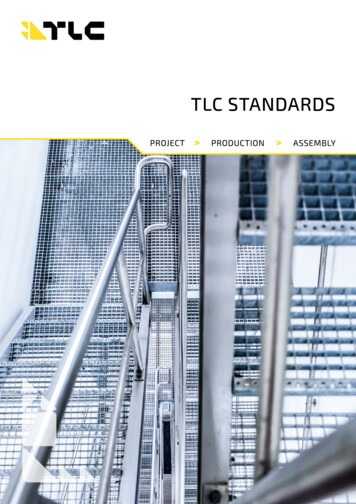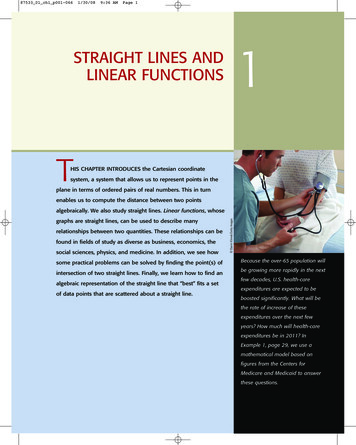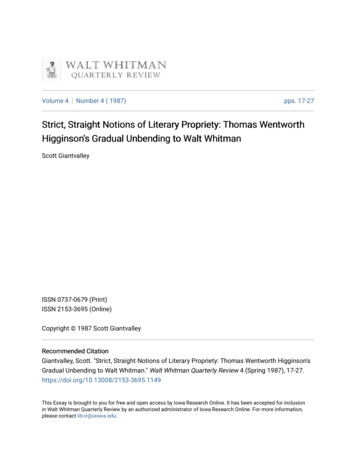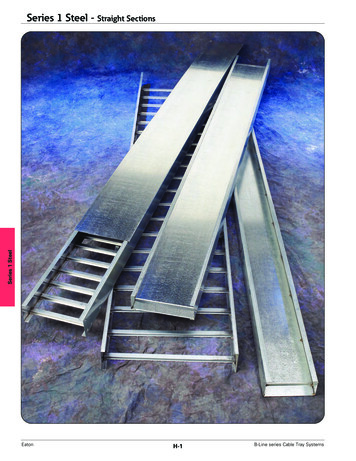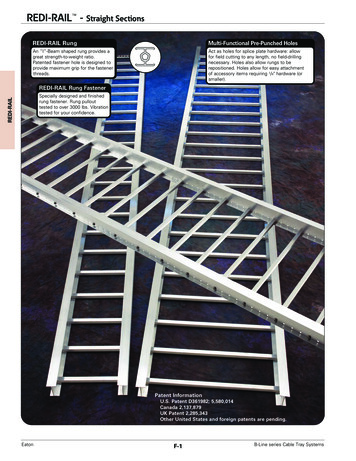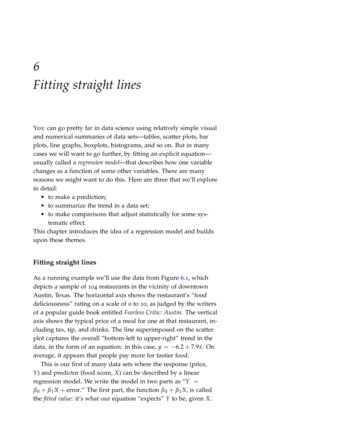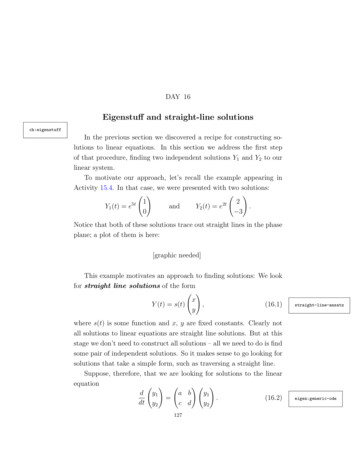
Transcription
DAY 16Eigenstu and straight-line solutionsch:eigenstuffIn the previous section we discovered a recipe for constructing solutions to linear equations. In this section we address the first stepof that procedure, finding two independent solutions Y1 and Y2 to ourlinear system.To motivate our approach, let’s recall the example appearing inActivity 15.4. In that case, we were presented with two solutions:!!12Y1 (t) e5tandY2 (t) e2t.03Notice that both of these solutions trace out straight lines in the phaseplane; a plot of them is here:[graphic needed]This example motivates an approach to finding solutions: We lookfor straight line solutions of the form!xY (t) s(t),(16.1)ywhere s(t) is some function and x, y are fixed constants. Clearly notall solutions to linear equations are straight line solutions. But at thisstage we don’t need to construct all solutions – all we need to do is findsome pair of independent solutions. So it makes sense to go looking forsolutions that take a simple form, such as traversing a straight line.Suppose, therefore, that we are looking for solutions to the linearequation!!!a by1d y1 .(16.2)dt y2c dy2127straight-line-ansatzeigen:generic-ode
12816. EIGENSTUFF AND STRAIGHT-LINE SOLUTIONSIf we plug in a generic straight line function of the form (16.1) we findthat we need!!!xabxs0 (t) s(t).yc dyWe can assume that s(t) is not the zero function (because otherwisewe don’t get an interesting solution) and rewrite this equation as!!!a bxs0 (t) x .(16.3)s(t) yc dyWe now make an interesting observation: The left side of (16.3) doesnot depend on t: the entries of the matrix are constant and the entriesof the vector are constant. Since the left side is constant in time, theright side must be as well. Thus we conclude the following: If(16.1)is going to be a straight line solution to (16.2), then it must be thecase that s0 (t)/s(t) is constant. It is traditional to label this constantwith the Greek letter . Replacing s0 (t)/s(t) by , the condition (16.3)becomes!!!a bxx ,(16.4)c r with the condition thats0 (t) .s(t)(16.5)Notice something amazing: the equation (16.4) does not involve anycalculus. . . or even any functions! It is simply an algebraic equationwhere there are three unknowns: x, y, and . In fact, (16.4) is reallyjust two equations with three unknowns. So it seems reasonable that wewould be able to find several solutions. In other words, the prospectsof finding straight-line solutions to (16.2) seem rather good.The discussion in the previous paragraph suggests an approach forfinding straight line solutions: First, find!xandyscaling-ode
16. EIGENSTUFF AND STRAIGHT-LINE SOLUTIONS129that satisfy (16.4). Second, using that value of , find a function s(t)that satisfies (16.5). Finally, building our straight line solution usingthe formula (16.1) that we started with.Before attempting to execute this procedure to specific examples,it is worth taking a moment to recall why we are seeking straight linesolutions in the first place. Remember that our goal is to construct ageneral solution to (16.2) of the formY (t) Y1 (t) Y2 (t),(16.6)eigen:linear-combowhere Y1 (t) and Y2 (t) are independent solutions. Our plan is to findY1 (t) and Y2 (t) that are straight line solutions of the form (16.1) bysolving (16.4) and (16.5). Since in (16.6) we will be multiplying Y1and Y2 by arbitrary constants and , we don’t need to worry aboutincluding any free constants in our scaling solution. This implies thatwe can take the solution to (16.5) to be simplys(t) etand that all the difficult work involves finding solutions to (16.4). Furthermore, since we want Y1 (t) and Y2 (t) to be independent, we do notwant both x and y in (16.4) to be zero.We now turn to the problem of finding x, y, satisfying (16.4),where we require that we don’t have both x and y zero. This problemis called the eigenvalue problem for the matrix!a b.(16.7)c deigen:basic-matrixWe write equation (16.4) as(a)x by 0cx (d)y 0 abcd!xy! !0.0(16.8)We now take a moment to study equations of this form; for convenience, we set A a, B b, C c, D (d) so that thesimplified-eigenvalue-pro
13016. EIGENSTUFF AND STRAIGHT-LINE SOLUTIONSsystem isAx By 0Cx Dy 0. A BC D!xy! !0.0(16.9)generic-linear-systemBy multiplying the first equation by D and the second equation by B,and then subtracting, we find that(ADBC)x 0.Similarly by multiplying the first by C and the second by A, and thensubtracting, we find that(ADBC)y 0.Thus we see that in order to have x and y satisfying (16.9) and haveat least one of x or y be not zero, then we must haveADThe quantity ADBC 0.BC is called the determinant of the matrix!A B.C DWhat we have just discovered is that in order to have a non-zero solution to (16.9) the determinant of the matrix must be zero.We now apply this knowledge to (16.8). In order to have one of xor y not equal to zero, we must have(a)(d)bc 0.(16.10)The equation (16.10) is called the characteristic equation for thematrix (16.7).The solutions to the characteristic equation are called the eigenvalues of the matrix. The eigenvalues are precisely the values offor which we can find solutions x, y to (16.4) where at least one of x, yis not zero. Thus in order to construct our straight line solutions, weproceed as follows:characteristic-equation
16. EIGENSTUFF AND STRAIGHT-LINE SOLUTIONS131(1) Find the eigenvalues of the matrix appearing in our linearequation.(2) For each eigenvalue , find a corresponding non-zero vector!xysatisfying (16.4). This vector is called an eigenvector associated to eigenvalue .(3) For each eigenvalue, let s(t) e t . Use this function, togetherwith the associated eigenvector, to construct the straight linesolution as in (16.1).Assuming that this procedure yields two independent straight linesolutions, then we are able to construct a general solution to the differential equation using the superposition principle.Example 16.1. Consider the di erential equation!2 1dY Y.dt1 2The characteristic equation for the matrix is(2)21 0.The solutions to the characteristic equation are1We focus on2 11 21! 3and2 1. 3. In this case (16.4) becomes!!2x y 3xxx 3 yyx 2y 3yBoth of these equations reduce to x y. Thus we choose our eigenvector to be!1.1
13216. EIGENSTUFF AND STRAIGHT-LINE SOLUTIONSSince s1 (t) e1t e3t , the corresponding straight line solution is!1Y1 (t) e3t.1We now focus on 1 1. In this case (16.4) becomes!!!2x y x2 1xx 1 1 2yyx 2y yBoth of these equations reduce to x y. Thus we choose our eigenvector to be!1.1Since s2 (t) e2t et , the corresponding straight line solution is!1Y2 (t) et.1Since the two functions s1 and s2 do not simultaneously vanish, andsince the two eigenvectors are independent, we have have constructedtwo independent straight line solutions. Using the superposition principle, we conclude that a general solution to the di erential equationis!!11Y (t) e3t et.11Activity 16.1. Find the general solution to the system!4 7dY Ydt5 6Activity 16.2. Find the general solution to the system!9 4dY Ydt5 1We have now developed an approach for finding solutions to linearsystems of equations. Our plan now is to use this approach in order tounderstand the phase space diagrams for these systems. In particular,we want to use the method of “eigenstu ” to understand the stability
EXERCISES133of the equilibrium point at (y1 , y2 ) (0, 0). As you will soon see, thestability of this equilibrium is determined primarily by the eigenvalues of the matrix that determines the equation. These eigenvalues, ofcourse, are the solutions to the characteristic equation (16.10). Sincethe characteristic equation is quadratic, we see that there are a numberof cases to consider: the case of two real solutions, the case of one realsolution, and the case of no real solutions. In the next several sectionswe systematically deal with each of these cases, beginning with the casewhen there are two distinct real eigenvalues.ExercisesFindThoseEigenvaluesExercise 16.1. Find the eigenvalues and the corresponding eigenvectors of the following matrices:(1)EStuff-Last4 31 2!(2)2 11 2!(3)4 53 2!Exercise 16.2. Find the explicit solution of the following IVP.!!11 308dY Y,Y (0) .dt4113
132 16. EIGENSTUFF AND STRAIGHT-LINE SOLUTIONS Since s 1(t) e 1t e3t, the corresponding straight line solution is Y 1(t) e3t 1 1!. We now focus on 1 1. In this case (16.4) becomes 21 12! x y! 1 x y! 2x y x x 2y y Both of these equations reduce to x y. Thus we choose our eigen-vector to be 1 1!. Since s 2(t) e 2t et, the corresponding straight line solution is Y 2(t) et 1 1!.
